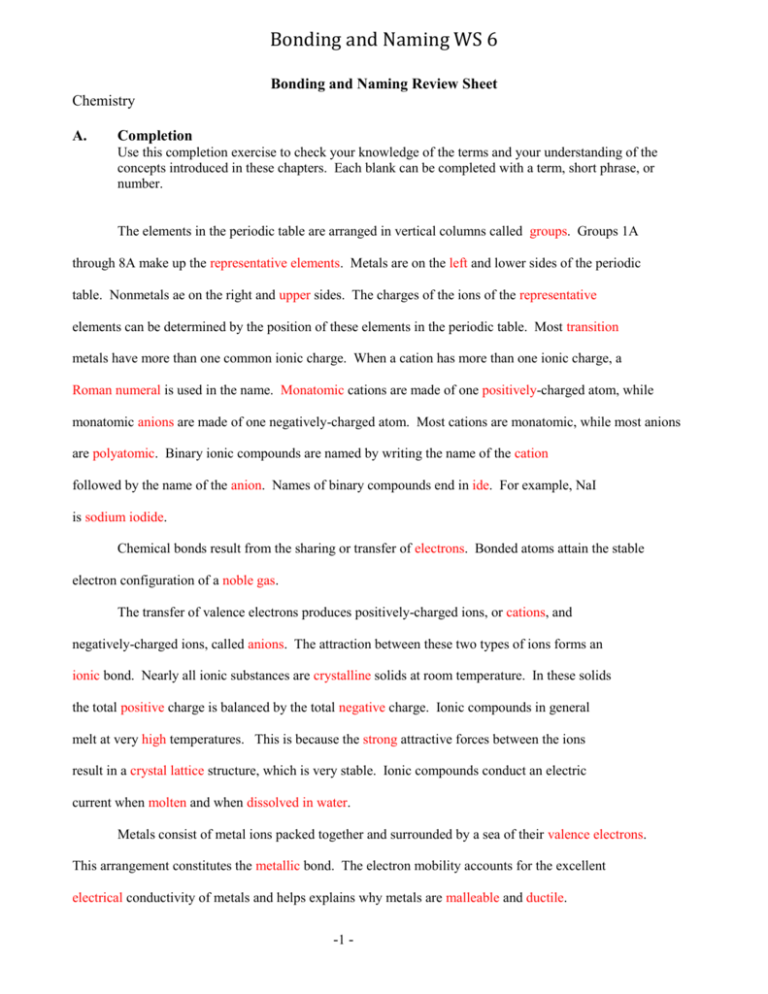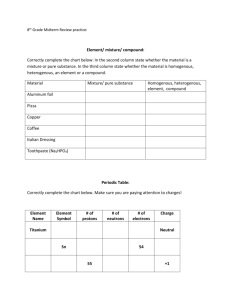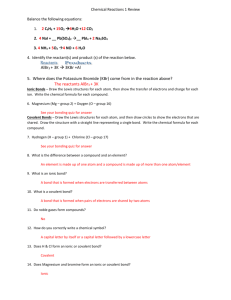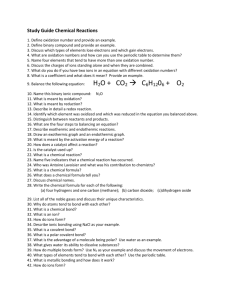Bonding and Naming WS 6
advertisement

Bonding and Naming WS 6 Bonding and Naming Review Sheet Chemistry A. Completion Use this completion exercise to check your knowledge of the terms and your understanding of the concepts introduced in these chapters. Each blank can be completed with a term, short phrase, or number. The elements in the periodic table are arranged in vertical columns called groups. Groups 1A through 8A make up the representative elements. Metals are on the left and lower sides of the periodic table. Nonmetals ae on the right and upper sides. The charges of the ions of the representative elements can be determined by the position of these elements in the periodic table. Most transition metals have more than one common ionic charge. When a cation has more than one ionic charge, a Roman numeral is used in the name. Monatomic cations are made of one positively-charged atom, while monatomic anions are made of one negatively-charged atom. Most cations are monatomic, while most anions are polyatomic. Binary ionic compounds are named by writing the name of the cation followed by the name of the anion. Names of binary compounds end in ide. For example, NaI is sodium iodide. Chemical bonds result from the sharing or transfer of electrons. Bonded atoms attain the stable electron configuration of a noble gas. The transfer of valence electrons produces positively-charged ions, or cations, and negatively-charged ions, called anions. The attraction between these two types of ions forms an ionic bond. Nearly all ionic substances are crystalline solids at room temperature. In these solids the total positive charge is balanced by the total negative charge. Ionic compounds in general melt at very high temperatures. This is because the strong attractive forces between the ions result in a crystal lattice structure, which is very stable. Ionic compounds conduct an electric current when molten and when dissolved in water. Metals consist of metal ions packed together and surrounded by a sea of their valence electrons. This arrangement constitutes the metallic bond. The electron mobility accounts for the excellent electrical conductivity of metals and helps explains why metals are malleable and ductile. -1 - Bonding and Naming WS 6 When atoms share electrons to gain the stable electron configuration of a noble gas, the bonds formed are covalent. A shared pair of valence electrons constitutes a single covalent bond. Sometimes two or three pairs of electrons may be shared to give double or triple covalent bonds. In some cases only one of the atoms in a bond provides the pair of bonding electrons; this is a coordinate covalent bond. When like atoms are joined by a covalent bond, the bonding electrons are shared equally, and the bond is nonpolar. When the atoms in a bond are not the same, the bonding electrons are shared unequally, and the bond is polar. The degree of polarity of a bond between any two atoms is determined by consulting a table of electronegativities. Some molecules are polar because they contain polar covalent bonds. The attractions between opposite poles of polar molecules are called intermolecular forces. The weakest intermolecular force is called dispersion or London forces, formed when the electrons of any atom or molecule temporarily form a dipole. The strongest intermolecular force is the hydrogen bond. These intermolecular forces determine whether a covalent compound will be a solid, liquid, or gas at room temperature. As a general rule, molecules adjust their three-dimensional shapes so that the valence shell electron pairs around a central atom are as far apart as possible. This is the guiding principle in the valence-shell electron-pair repulsion, or VSEPR theory of molecular geometries. Molecular compounds are composed of two or more nonmetals. The representative particle of a molecular compound is a molecule. Binary molecules are composed of two nonmetal elements. The name of this type of compound ends in ide. Prefixes are used to show how many atoms of each element are present in a molecule of the compound. For example, As2S5 is diarsenic pentasulfide. Compounds of the general formula HX, where X is an anion, are named as acids when in water solution. HBr, named as an acid, is hydrobromic acid. -2 - Bonding and Naming WS 6 B. True-False Classify each of these statements as always true (AT); sometimes true (ST); or never true (NT). __ST___ 1. In forming a chemical compound, an atom of an element gains more electrons. __NT___ 2. An anion is any atom or group of atoms with a positive charge. __ST___ 3. The names of polyatomic ions end in –ite or –ate . __AT___ 4. In polyatomic ions for which there is an –ite/–ate pair, the –ite ending will always indicate one less oxygen atom than the –ate ending. __AT___ 5. In writing a formula for an ionic compound, the net ionic charge of the formula must be zero. __NT__ 6. In a polar covalent bond the more electronegative atom has a slight positive charge. __ST__ 7. A molecule with polar bonds must itself be polar. __AT___8. A hydrogen bond must involve a hydrogen atom that is covalently bonded to a very electronegative atom. __NT__ 9. To attain a noble gas electron structure, a nitrogen atom must lose its five valence electrons. __NT__10. The compound OF2 contains two double covalent bonds. __AT__11. Unshaired pairs of electrons affect the shape of molecules. __ST__12. Covalent compounds are network solids. C. Questions Answer the following questions in the space provided. 1. Name the following compounds and tell what type of compound they are (ionic or molecular), using differences in electronegativity. a. CaBr2 calcium bromide, ionic b. CBr4 carbon tetrabromide, molecular c. Na2Cr2O7 sodium dichromate, ionic -3 - Bonding and Naming WS 6 2. Write the formulas for the following ionic compounds. a. sodium chlorate NaClO3 b. lead (II) phosphate Pb3(PO4)2 c. magnesium hydrogen carbonate Mg(HCO3)2 3. State the number of electrons gained or lost in forming each of these ions. a. Mg2+ loses 2 electrons c. Br- gains 1 electron b. Ca2+ loses 2 electrons d. Ag+ loses 1 electron 4. Name each of the ions in Question #3 and tell whether they are anions or cations. a. Mg2+ magnesium ion, cation c. Br- bromide ion, anion b. Ca2+ calcium ion, cation d. Ag+ silver ion, cation 5. Use electron dot structures to describe the chemical formulas of the ionic compounds formed when the following elements combine. a. strontium and fluorine Sr2+ 2[F]- The fluoride ion has 8 dots around it, 2 per side b. magnesium and chlorine Mg2+ 2 [Cl]- The chloride ion has 8 dots around it, 2 per side c. sodium and oxygen 2 Na+ [O]2- The oxide ion has 8 dots around it, 2 per side d. aluminum and sulfur 2 Al3+ 3 [S]2- The sulfide ion has 8 dots around it, 2 per side -4 - Bonding and Naming WS 6 6. Draw electron dot diagrams for the following molecules or polyatomic ions: a. Br2 b. SO32- c. NH4+ Br:Br S with O’s around 3 sides, lone pair on 4th side, square brackets, 2- outside N in the middle, with 4 H’s, one on each side, square brackets, 1+ outside 7. Determine whether each of the following bonds is nonpolar covalent, polar covalent or ionic, using differences in electronegativities. Show your work. a. BeCl2 3.0-1.5 = 1.5, polar covalent b. O2 nonpolar covalent – same element, so electronegativity difference is 0 c. K2S 2.5-0.8 = 1.7, polar covalent or ionic 8. Arrange the following intermolecular forces in order of increasing strength: dipole, dispersion (London) forces, hydrogen bonds. Dispersion, dipole, hydrogen bond 9. From the list below select the compound that is best described by each statement, and write the formula in the space next to it. H2O, CCl4, NH3, CO2 a. Which compound represents a linear molecule? b. Which compound best represents a tetrahedral molecule? CCl4 c. Which compound would show a bent molecular structure? H2O d. Which compound’s molecules have a pyramidal shape? NH3 e. Which compound(s) is/are polar? 10. CO2 H2O, NH3 Write formulas for the following acids: a. chlorous acid HClO2 b. hydrofluoric acid HF -5 - c. phosphoric acid H3PO4







